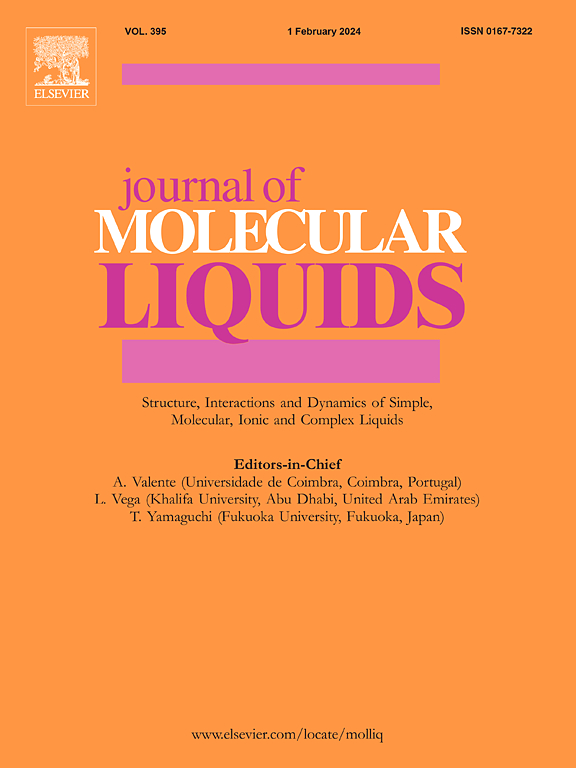Solvent-dependent photophysical and photochemical properties of genistein: Insights from spectroscopic and quantum chemical analysis
IF 5.3
2区 化学
Q2 CHEMISTRY, PHYSICAL
引用次数: 0
Abstract
Experimental (steady-state absorption and fluorescence techniques) and quantum chemistry (density functional theory (DFT) calculations) methods have been used in order to investigate the solvent-dependent photophysical and photochemical properties of genistein (GEN) – isoflavone with potential therapeutic applications, particularly in the treatment of neurodegenerative diseases such as Alzheimer's disease. The effect of microenvironment on spectral behaviour was analyzed in terms of three models: the Reichardt's single parameter polarity scale (), the linear solvation energy relationship (LSER) developed by Catalán, solvatochromic shift methods based on the Onsager's description of universal solute-solvent interactions. The experimental results, supported by quantum chemical calculations, indicate that both non-specific and specific (hydrogen bond) interactions contribute to the observed solvatochromism. Since a general understanding of the effect of microenvironment on the GEN solvatochromism cannot be achieved without determining the values of the dipole moment in the ground () and excited () states, these important physical parameters were obtained using solvatochromic shift methods and quantum chemical calculations. Additionally, the role of solute polarizability on the obtained dipole moment values is also addressed. In the light of our studies, it can be concluded that understanding the molecular mechanisms underlying GEN-microenvironment interactions is of great importance considering its therapeutic applications.

染料木黄酮的溶剂依赖性光物理和光化学性质:来自光谱和量子化学分析的见解
实验(稳态吸收和荧光技术)和量子化学(密度泛函数理论(DFT)计算)方法已被用于研究染料木黄酮(GEN)异黄酮的溶剂依赖性光物理和光化学性质,其具有潜在的治疗应用,特别是在治疗神经退行性疾病如阿尔茨海默病方面。利用Reichardt的单参数极性尺度(ENT)、Catalán建立的线性溶剂化能关系(LSER)和基于Onsager描述的溶质-溶剂相互作用的溶剂致变色位移方法,分析了微环境对光谱行为的影响。量子化学计算支持的实验结果表明,非特异性和特异性(氢键)相互作用都有助于观察到的溶剂变色。由于不确定基态(μ→g)和激发态(μ→e)偶极矩的值,就无法对微环境对GEN溶剂致变色的影响有一般的了解,因此这些重要的物理参数是通过溶剂致变色位移法和量子化学计算得到的。此外,还讨论了溶质极化率对偶极矩值的影响。根据我们的研究,可以得出结论,了解基因-微环境相互作用的分子机制对于其治疗应用具有重要意义。
本文章由计算机程序翻译,如有差异,请以英文原文为准。
求助全文
约1分钟内获得全文
求助全文
来源期刊

Journal of Molecular Liquids
化学-物理:原子、分子和化学物理
CiteScore
10.30
自引率
16.70%
发文量
2597
审稿时长
78 days
期刊介绍:
The journal includes papers in the following areas:
– Simple organic liquids and mixtures
– Ionic liquids
– Surfactant solutions (including micelles and vesicles) and liquid interfaces
– Colloidal solutions and nanoparticles
– Thermotropic and lyotropic liquid crystals
– Ferrofluids
– Water, aqueous solutions and other hydrogen-bonded liquids
– Lubricants, polymer solutions and melts
– Molten metals and salts
– Phase transitions and critical phenomena in liquids and confined fluids
– Self assembly in complex liquids.– Biomolecules in solution
The emphasis is on the molecular (or microscopic) understanding of particular liquids or liquid systems, especially concerning structure, dynamics and intermolecular forces. The experimental techniques used may include:
– Conventional spectroscopy (mid-IR and far-IR, Raman, NMR, etc.)
– Non-linear optics and time resolved spectroscopy (psec, fsec, asec, ISRS, etc.)
– Light scattering (Rayleigh, Brillouin, PCS, etc.)
– Dielectric relaxation
– X-ray and neutron scattering and diffraction.
Experimental studies, computer simulations (MD or MC) and analytical theory will be considered for publication; papers just reporting experimental results that do not contribute to the understanding of the fundamentals of molecular and ionic liquids will not be accepted. Only papers of a non-routine nature and advancing the field will be considered for publication.
 求助内容:
求助内容: 应助结果提醒方式:
应助结果提醒方式:


